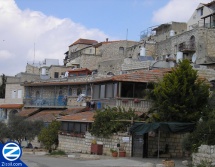HaMeiri Museum Safed
As Keren HaYesod Road meets “Kiryat Breslev” -- the Breslev neighborhood -- at the base of the Old City of Tzfat, the HaMeiri Museum offers visitors an opportunity to learn about the history and daily lives of Jews who lived in Tzfat in the 19th and early 20th centuries. The museum includes a historical timeline of the Jewish community of the city as well as artifacts and testimonials that give visitors a glimpse into the difficulties that Jews of Safed faced.
Contents |
[edit] Museum Building’s History
After the devastating earthquake of 1837, emissaries from Tzfat traveled to Jewish communities throughout the world to ask for help for the surviving Jews. In Iran, Meir Mizrachi saw the opportunity to help the Jews of Tzfat as a mission that he would assist from up close. He immigrated, together with his family, to Safed and established his home in a 16th century building located on the edge of Tzfat’s ancient cemetery.
[edit] HaMeiri Home
The building which the Mizrachi family settled had been partially destroyed by the 1759 earthquake and subsequently rebuilt. The 1837 earthquake again destroyed part of the building and the Mizrachi family renovated it. They established a dairy in the southern portion of the building. Meir Mizrachi changed his family name to “HaMeiri.”
[edit] Late 19th and Early 20th Century
Prior to the First World War the building served as the Sepharadic “Beit Din” -- rabbinical court -- of Tzfat. It also sheltered children orphaned before and during World War I. Baron de Rothchild provided the funds to establish the first non-religious “Hebrew School” which opened at the site. The building was partially burned during the Arab riots of 1929 and several residents of the building were among the 20 victims who were murdered.
[edit] Struggle for Independence
After 1929 “Beit HaMeiri” -- HaMeiri House -- became an arms “slick” -- a depot where weapons were illegally stored by the pre-State underground organizations, the Haganah, Etzel and the Irgun. Members of these organizations trained in the building. HaMeiri House served as one of the main posts guarding the Jewish Quarter from the Arabs during the War of Independence.
[edit] Renovation
Beginning in 1959 Yehezkel HaMeiri began to collect artifacts that would provide an opportunity for visitors to learn more about Jewish history and settlement in Tzfat. He renovated the building and established a museum, Beit HaMeiri.
[edit] Museum
The objective of the museum is to give visitors a sense of the struggles and challenges that residents faced in Tzfat. The museum includes artifacts and documents as well as an archive with information about the residents of the city.
[edit] Day to Day Life
In addition to the collection of utensils and tools used by residents of Tzfat during the 19th and early 20th century, the museum features a room which was restored in the style of 19th century Tzfat, The room illustrates the simple and meager Tzfat home of the period when entire families lived in one room.
[edit] Religious Life
A room dedicated to the religious life of Tzfat shows the ritual objects that Jews used in their religious practices. The room includes parchments and scrolls, objects used for rituals and items that people kept to enhance and beautify various observances. Tzfat has members of Jewish communities who originated in various parts of the world and the HaMeiri museum demonstrates this with ritual objects that present the customs and traditions of Jews of many different backgrounds and ethnicities.
[edit] Heros
Tzfat Jews played a major role in Israel’s victory both before and during the War of Independence. The museum displays various objects, documents and personal stories that relate the story of the Jewish fight for liberation, both in Tzfat and elsewhere in Israel. The exhibition is displayed in a room which served as a defensive position during the War of Independence. Defenders guarded the Jewish Quarter from this room and the exhibition depicts these battles as well as other incidents which led to the liberation of the city.
Paintings and photos of some of the Tzfat residents of the 1800s and 1900s hang in the domed hallways of the museums along with their individual stories.
[edit] Visitors
The HaMeiri Museum is open daily from 9:30a.m. to 2:30 p.m. and until 12:00p.m. on Fridays.
[edit] Tours and Reenactments
During holidays and summer holidays the museum offers guided tours of the premises. Actors stage reenactments of life of Tzfat Jews during the 19th century, including period costumes, for groups. Groups must make a reservation for such a reenactment.
[edit] HaMeiri Dairy
Also contained in the building is dairy which also allows entry to tourists.
![]() Read full Zissil article on the Meiri Dairy
Read full Zissil article on the Meiri Dairy
[edit] Schools
The museum is an attraction for many school and army groups who come to learn more about Jewish history of the Land of Israel.
| |||||||||||||||||
| ||||||||||||||
| |||||||||||||||||



